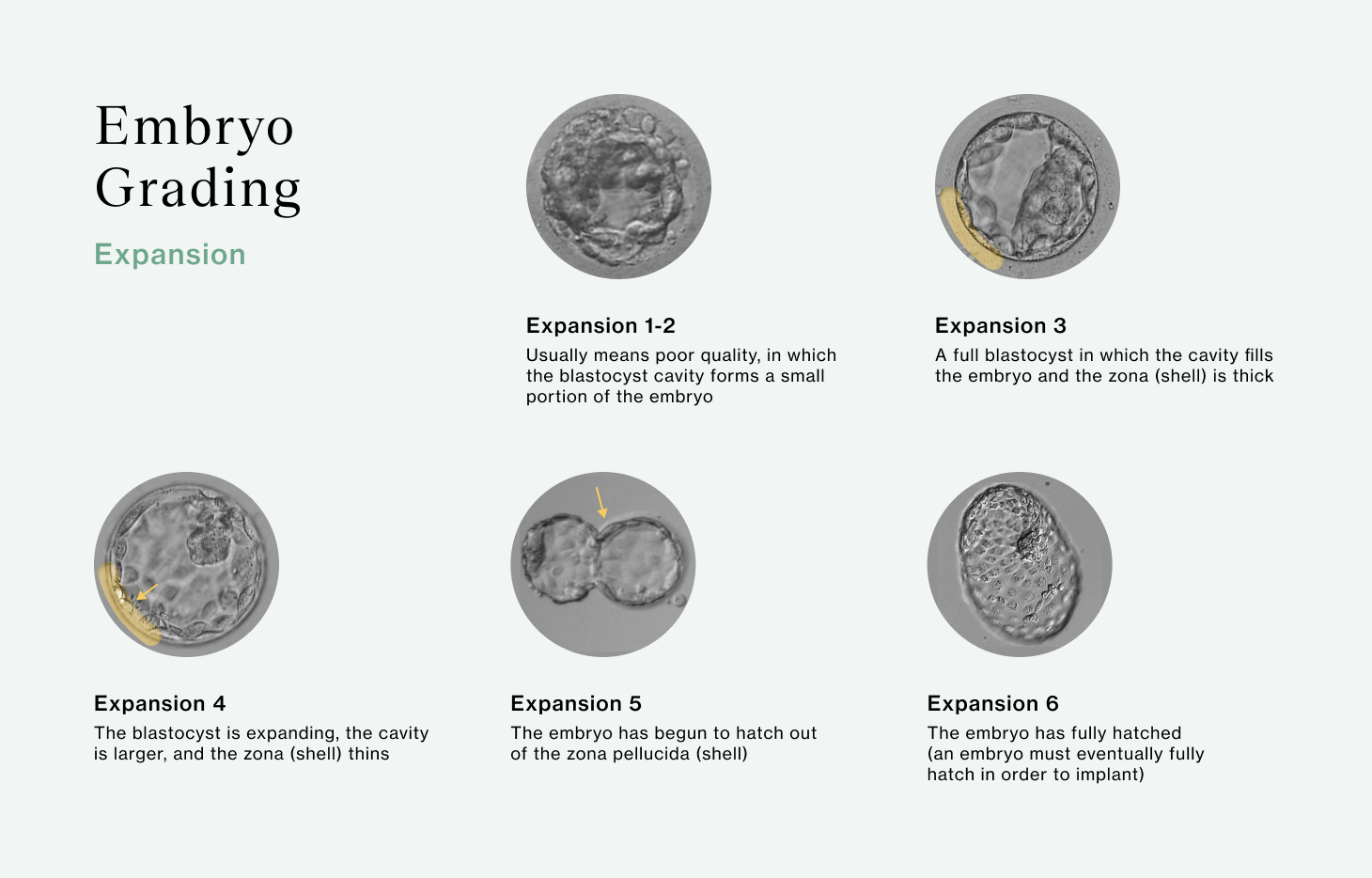Embryo Grading Explained

By Kevin Loewke, Ph.D, Head of Data Science
Embryo grading is a system embryologists use to assess the quality of embryos created through in vitro fertilization (IVF). By looking carefully at each embryo’s form and structure, the embryologist can determine which embryo or embryos have the best chance of success.
To understand how this process works and why they choose certain embryos over others, it helps to start with understanding how an embryo forms and grows.
How does an embryo form?
After your eggs have been retrieved and fertilized, the resulting embryos will grow in culture in the lab for 3-7 days. During this time, the embryo changes rapidly!

How does the embryologist decide which embryo to choose?
In the late 1990s, Dr. David Gardner developed and published a grading system to help embryologists determine the quality of an embryo. Based on this system, embryos are given an alphanumeric score that describes the morphological appearance (the form and structure) of an embryo. While Gardner’s system is still the most widely used, there are still several different grading systems. Your lab may have its own "custom" grading system that is more or less complex than the Gardner grading system.
The Gardner grading system involves 3 quality scores:
- Expansion - How expanded the embryo cavity is.

- Inner Cell Mass (ICM) - The cells inside the embryo that will form into a fetus.

- Trophectoderm (TE) - The cells lining the embryo that will become the placenta.

Based on this system, a high quality embryo could have a grade of 4AA or 5AA, but embryos with lower scores are still capable of implanting and growing into a healthy baby. For example, there’s not much data to support which degree of expansion is best, so it’s hard to say if a 4AA embryo is better than 5AA. It’s also not clear whether the ICM or TE is more important in determining the quality of the embryo.
The other important component of embryo grading is the day an embryo reaches the blastocyst stage. If the embryo reaches blastocyst stage on day 5, rather than day 6 or 7, that’s an indication that it’s developing well. An embryo that takes 6 or 7 days to reach blastocyst stage may indicate an issue with cell division timing. However, day 6 and 7 blastocysts are still viable and capable of implanting.
Why does embryo grading matter?
Embryo grading helps embryologists and physicians understand the quality of a patient’s embryos, and decide which ones to prioritize for transfer. While a good quality embryo has a better chance of a successful outcome (live birth) than a poor quality embryo, the grade alone does not guarantee a certain outcome.
It’s important to remember that manual morphology grading is subjective. Depending on the lab and embryologist, scoring can vary. Today, many labs will perform PGT-A in addition to embryo grading to determine which embryos are euploid (chromosomally normal) and which are aneuploid (chromosomally abnormal). The standard of care for those clinics is to prioritize the transfer of euploid embryos with the best morphological grade.
Ultimately, embryo grading is a useful tool for your doctors to use to give your IVF cycle the best possible chance of success at the point of transfer.
Embryo grading success rates
You may be thinking, “yes, embryo grading matters, but exactly how much?”
As you can see in the chart below, which shows the average live birth rates calculated from 5 different IVF clinics in the U.S., the embryo grade corresponds to the likelihood of clinical pregnancy and live birth.
| Embryo Grade | Clinical Pregnancy | Live Birth Rate |
|---|---|---|
| AA | 63% | 58% |
| BB | 51% | 46% |
| CC | 27% | 23% |
| Embryo Grade: AA | |
|---|---|
| Clinical Pregnancy | 63% |
| Live Birth Rate | 58% |
| Embryo Grade: BB | |
| Clinical Pregnancy | 51% |
| Live Birth Rate | 46% |
| Embryo Grade: CC | |
| Clinical Pregnancy | 27% |
| Live Birth Rate | 23% |
It’s important to note that the embryo grade is just one factor in determining the chance of a live birth. Additionally, the embryo grade looks only at an embryo’s chance of implanting and developing.
How can artificial intelligence help with embryo grading?
Embryo grading is not a cut and dry process. Morphological grades like the ones given in the Gardner grading system are subject to variability between embryologists and clinics. In other words, two different embryologists could give the same embryo a different grade.
Artificial intelligence (AI) has the potential to help even out this variability and provide more consistent embryo grades. A study conducted by data scientists at Alife Health and published in Fertility and Sterility found that an AI model has the potential to standardize embryo grading and may improve pregnancy outcomes.
AI can also seamlessly combine the grade with other patient-specific factors to help embryologists prioritize embryos for transfer.
Recent Articles
References
- Lai, I., Neal, M., Gervais, N., Amin, S., Taerk, E., & Faghih, M. (2020). Transfers of lower quality embryos based on morphological appearance result in appreciable live birth rates: a Canadian center’s experience. F&S Reports, 1(3), 264–269. https://doi.org/10.1016/j.xfre.2020.09.003
Share this
Recent Articles

Learn everything you need to know about IVF
Join the newsletter for IVF education, updates on new research, and early access to Alife products.



